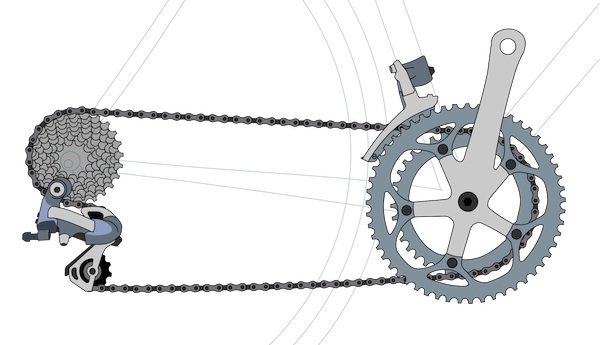Bike Gears – How They Work

Bikes have anywhere from one front chainring to three chainrings these days, accompanied by seven to eleven gears in the back. The different combinations of these gears will determine how easy or difficult it is to pedal and will dictate your speed. If you are looking to make small adjustments in the speed/difficulty then you will want to change your back gears (also known as cogs).
If you are looking to make a big change in your effort or speed then you will likely want to change the front chainring. A great example would be when you are heading from a downhill in the big ring and then switching to the small chainring as you climb up the other side of the hill.
Shifting Bike Gears
Left Shifter – Changes the front chainring and makes the biggest shift change.
Right Shifter – Changes the rear cogs and makes the smallest incremental shift changes.
What Is the Proper Gear To Be In?
The appropriate gear to be in is a gear that allows you to have a good steady cadence without feeling like you are pedaling too hard or too gently.
If you select a gear that is too high for the conditions, it will force you into a slower cadence. Pedaling slower than your ideal cadence is wasteful of energy. You also run a higher risk of muscle strains and joint damage, particularly to the knees and hips. Pedaling faster than your ideal cadence can allow you to generate an extra burst of speed, but you will tire yourself out too soon if you try to maintain an excessively fast cadence.
Aim for a constant cadence of 75 – 95rpm.
What To Avoid When Changing Bike Gears
Cross chaining occurs when the chain is on a big slant. The chain should not go on the big ring up front and the big ring on the back simultaneously, nor should it go on the small ring upfront and the small ring in the back. Cross chaining wrecks your chain, decreases efficiency and it also gives you less options when trying to find a new gear.
Using Bike Gears
- To begin with, start in your small chainring up front.
- Get on your bike and become familiar with changing your back gears with your right shifter.
- Get comfortable shifting through the gears (while avoiding cross chaining) before you start shifting with the front gears as well.
- Attempt to maintain a smooth steady cadence of about 75 – 95 rpm while maintaining a moderate effort when pushing on the pedals. Change the gears appropriately to maintain this steady cadence and effort.
How To Use Bike Gears On a Hill
Use the small or middle chainring upfront and the bigger gears in the back. You will want to switch in to these gears early as you approach the climb allowing you to climb the hill slowly and with less effort.
How To Use Bike Gears On a Flat
Use the middle front chainring and the middle or small gears in the back. Focus on small adjustments with your back gear.
How To Use Bike Gears Descending
Use the large front chainring and the middle or small gears in the back.